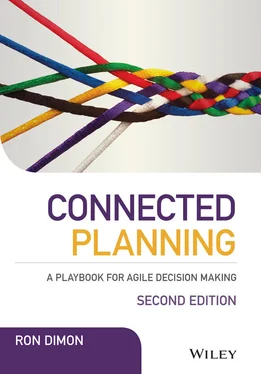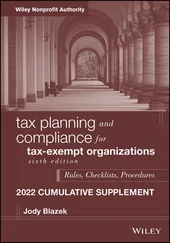Chapter 7: Understand: Why Did We Get the Results We Got? Connected Planning as a process not only helps set targets, it also helps explore and understand why you met, exceeded, or missed those targets. This chapter explores approaches to understanding results through business questions and includes the ideas behind “Big Data” and predictive analytics.
Chapter 8: Execute: From Insights to Actions to Results. Chapter 8is a collection of Connected Planning use cases across a variety of business functions, including Sales and Marketing, Supply Chain, and Human Resources, and processes like order-to-cash. From this chapter you see how Connected Planning can be applied to any area of the business . . . not just Finance.
Chapter 9: Strategy: Everyone Aligned to the Right Outcomes. Connected Planning works when it's aligned with and in support of an organization's strategic objectives. Chapter 9covers several topics on aligning connected planning to strategy including the ever-popular Profitability Management.
Chapter 10: Digital Planning. A new chapter in this edition, Chapter 10gives an overview of newer digital technologies that can surround and improve Connected Planning ecosystems.
Chapter 11: Bringing It All Together. Chapter 11is all about developing your next-generation planning roadmap based on the concepts and practices discussed in this book. It helps you sell Connected Planning internally, ties up a few loose ends, and addresses what it takes to become world class in Connected Planning adoption.
Typically, budgeting, planning, and forecasting are thought of as solely Finance or Information Technology initiatives and can easily be put in the “operational efficiency through automation” bucket of benefits. Which is just a fancy way of saying a corporate cost-cutting program. However, in order for Connected Planning to really matter in the business, it has to have a direct impact on more than just operating margins. Ideally, it should provide your department, business unit, and company with one or more competitive advantages in the areas of:
Customer acquisition and retention
Product innovation and profitability
People productivity
Supply-chain efficiency
Marketing effectiveness
Overall sustainable execution of strategy
It is no longer an IT-led area but rather a joint IT, Finance, and Business concern that impacts all of these performance areas.
One of the first areas of the business to look at for financial performance and competitive advantage is revenue growth. There are a variety of ways that Connected Planning can improve revenue growth, including:
Better focus on sales productivity through more relevant, expedient sales forecasting
Better sales velocity by focusing efforts on the best-selling products, bundles, and channels
Maximized revenue by modeling product, bundle, and channel price mixes
Especially in a down economy, with the automatic reaction to cut costs, Connected Planning can help ensure you cut the “right” costs and that the removal of those costs doesn't adversely impact profitable revenue or future market share. Connected Planning can impact this area in many ways, for example:
Understanding customer and product profitability allows companies to focus on marketing and selling the products that give the best return.
Quickly modeling NewCo scenarios in a pending acquisition and basing those models on historical data and actual constraints (by product, by geography, by customer segment, etc.) can give a more accurate picture of available synergies to set the expectations of the street.
Accelerating your cash cycle gives you more confidence in working capital, better opportunities for investments, and improves overall efficiency. Connected Planning efforts can include:
Gathering and sharing information on Days Sales Outstanding (DSO), Days Payable Outstanding (DPO), and Days in Inventory (DII)—delivered to the right people in the organization (and tied to employee rewards)—can have a positive impact on cash cycle.
Cash-Flow forecasting and Working Capital analysis can help improve the cost of capital and debt ratios and can reduce risk.
Ensuring that assets such as plants, production lines, or equipment are being employed in profitable activities is the way of an efficient organization. A couple of ways that Connected Planning can impact your return on assets include:
Modeling capacity to ensure you have the right equipment availability, manpower, and output or yield
Scheduled versus unscheduled repair analysis to show how effective your preventative maintenance programs are
Making sure customers are attracted to your company and products and then retained for maximum lifetime value is one of the goals of most organizations. Connected Planning can help ensure that this happens by:
Showing if there's a correlation between customer satisfaction levels and customer support staffing
Analyzing customer satisfaction scores by product and product lifecycle over time, showing root causes for declines in product satisfaction
Tracking a plan to improve Net Promoter Score by department
With more awareness and accountability, employees at all levels of the organization can make decisions to improve both the top and bottom lines.
Connected Planning helps show how what you're working on is related to overall targets. For example, an accounts receivable (A/R) clerk can see how the velocity of receivables under his or her control can impact DSO, working capital, and free cash flow.
It encourages more sharing and collaboration of plans, analyses, and results, and reduces the need to re-create the wheel every time.
Organic Growth and Outperformance Management
The real goal of Connected Planning is to have a material impact on business performance, to standardize on one management operating system across an organization—for better performance visibility, execution, accountability, and organizational flexibility. What if you had a stretch goal of using Connected Planning not just for performance management, but for OUT-performance management?
How would we use Connected Planning to outperform your competitors on both revenue growth and profitability over the long term?
There are many ways to do this:
Organic growth is key—an intelligent investment in organic growth may provide more value than growth through acquisition. Connected Planning supports organic growth in many ways:Profitability planning with customer and market segmentation: spending more effort marketing and selling the most profitable product/service offerings to the right people at the right time at the right price (price modeling and analytics is a key component of this).Model, plan for, measure, and manage cross-selling and up-selling efforts. Use analytics to understand which cross-selling and up-selling initiatives work and how they can be replicated. Tie this into the pricing models as well.Look to adjacencies, for example, bundles with partner products/services (e.g., Nike + Apple Watch). These can capture new markets and pull along sales of your products. Including external parties (suppliers, partners, resellers) in your rolling revenue forecasting process gives you more visibility into opportunities.Market expansion: Connected Planning includes multidimensional modeling of different scenarios that can be risk-weighted, so, for example, if you want to expand to an emerging market, you can factor in risk from currency fluctuations, government regulations, and other assumptions. Once you have debated and selected the right model, you can use that as the basis for a capital expenditure plan, revenue and expense budget, and workforce plan.
Читать дальше












